Reducing the risk of space debris collision
An increase in space launches requires the development of a method to clear space debris which could collide with valuable equipment. One plausible method of achieving this through the use of a tug vehicle requires a successful connection procedure.
New York | Heidelberg, 17 June 2020
 As humanity expands its horizons beyond the Earth and begins to consider space missions with extended duration, sustainability necessitates the launch of more space vehicles, increasing the risk of collision with existing space debris. One method of clearing this debris involves a tug vehicle dragging it to a safe region. In a new paper published in EPJ Special Topics, authors Antônio Delson Conceição de Jesus and Gabriel Luiz F. Santos, both from the State University of Feira de Santana, Bahia, Brazil, model the complex rendezvous manoeuvres a tug vehicle clearing space debris would have to undergo to mitigate the risk of a collision that could cause irreparable damage at the moment of coupling.
As humanity expands its horizons beyond the Earth and begins to consider space missions with extended duration, sustainability necessitates the launch of more space vehicles, increasing the risk of collision with existing space debris. One method of clearing this debris involves a tug vehicle dragging it to a safe region. In a new paper published in EPJ Special Topics, authors Antônio Delson Conceição de Jesus and Gabriel Luiz F. Santos, both from the State University of Feira de Santana, Bahia, Brazil, model the complex rendezvous manoeuvres a tug vehicle clearing space debris would have to undergo to mitigate the risk of a collision that could cause irreparable damage at the moment of coupling.
As the authors point out, space missions occur in an environment populated by around 3,600 man-made satellites, of which under a third are operational. The non-operational units are subject to leakage, explosions and fragmentation further littering the region around the Earth – especially at Low-Earth Orbit (LEO). A botched collision could not only result in irreparable damage, but also the creation of more space debris that could hamper further missions. This makes towing operations to clear this debris desirable, but dangerous.
The duo studied the use of propulsion systems to control the objects’ relative velocities and positions in a rendezvous manoeuvre performed around the Earth. Such operations require that tow vehicle and the debris have null velocities and relative position at the moment of connection. Examining the parameters of these operations through the solutions of a multivariable tensor equation, de Jesus and Santos found that encounter manoeuvres of a space-debris towing vehicle can be implemented in minimal time and with a simultaneity that arises from bringing the velocity and relative final positions of the two objects to zero at the same instant.
The successful connection between objects in space can, of course, be applied in more scenarios than just the shifting of space debris. Connecting vehicles could become a vital part of the development of a sustainable long-term space mission.
References: de Jesus, A.D.C., Santos, G.L.F. Reducing the risk of space debris collisions using conditions or performance simultaneous operation in minimum time. Eur. Phys. J. Spec. Top. 229, 1419–1427 (2020). DOI 10.1140/epjst/e2020-900194-x
This paper is part of the EPJST special issue on "Celestial Mechanics in the XXIst Century"
Further Information
For more information visit: www.epj.org
Services for Journalists
The full-text article is available here.
Contact
Sabine Lehr | Springer | Physics Editorial Department
tel +49-6221-487-8336 | sabine.lehr@springer.com
